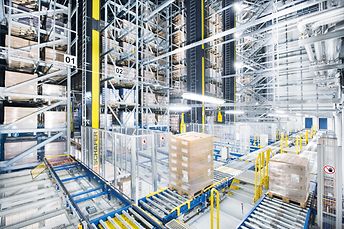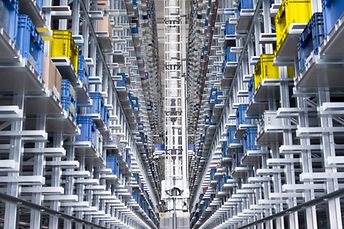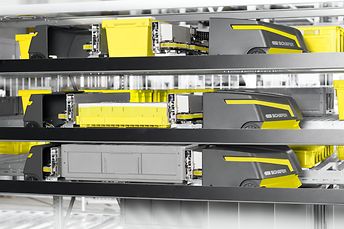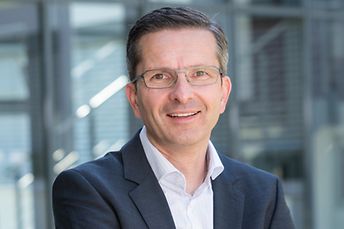

Everybody is talking about climate protection. Discussed in-depth in society and linked to global campaigns, the topic of sustainability is also increasingly becoming a decisive criterion in logistics to ensure whether the offered solutions are viable. This is nothing new for SSI SCHÄFER as the topic corresponds to the long-term view on Green Logistics that was firmly engrained at an early stage. This is part of our Think Tomorrow. philosophy according to which we plan logistics solutions that are tailored to our customers’ needs and continually optimized with a view towards long-term criteria - this is the basis of our success.
Critical for the carbon footprint of intralogistics projects is a holistic view on energy consumption. Holistic in this sense means that all areas of building, technology and operations are assessed together. In addition to evaluating the operational energy consumption, the energy consumption in production, service and retrofitting must also be assessed. This quickly elevates longevity to one of the most critical aspects of sustainability for logistical solutions. To achieve an overall optimal energy balance, highest priority is given to avoiding unnecessary energy requirements within the operation and throughout the entire life cycle. Any remaining necessary energy must be made available in an efficient manner and then also be recovered as efficiently as possible.
At SSI SCHÄFER, we generally rely on a coordinated layout when designing a system and take into consideration a balance of performance requirements, flexibility and longevity. Depending on the discipline, we utilize several different approaches to reach this goal. Below, we present three selected storage machines in detail, which ensure optimized performances in semi- and fully automated logistics environments. What distinguishes them sustainably? Which energy efficient benefits do they feature?
When developing the SSI Exyz family of storage and retrieval machines, the focus was on increasing efficiency: “E” stands for efficiency both in terms of energy consumption as well as in terms of space usage in all three dimensions “X,” “Y” and “Z” of a high-bay warehouse . The cleverly nested and as such extremely compact design combined with an optimized control significantly reduces the space requirement: in comparison with traditional high-bay warehouses, this allows space savings of up to 5%. This adds up to many cubic feet that do not have to be built, heated or air conditioned. Extremely low rolling resistances and the design of components built for several decades of trouble-free operation prevent energy waste in the mechanical design alone. Standards at SSI SCHÄFER include drive dynamics and drive curves optimized for demand, energy efficient drives and internal and external energy recovery.
SSI Exyz is the most innovative device on the market and accounts for the fact that when storing large load carriers, the most critical energy demand comes from the lifting unit. Energy savings can be achieved here from the start by using a counterweight integrated in the mast. These savings significantly outweigh any gains from energy recovery. SSI Exyz offers a mix of both – an absolutely unique selling point from SSI SCHÄFER.

In the technological development of the SSI Miniload, the storage and retrieval machine for containers, cartons and trays, particular emphasis was placed on ensuring low energy consumption and minimal wear of the individual components. In order to achieve this objective, SSI SCHÄFER designed specific profiles and components for the energy efficient design. The highly dynamic drives required to operate a miniload are intentionally designed to be interlocking and therefore slip-free so that they can convert the full drive power into motion. The drive control as a central component for energy efficiency compensates energy as a result of the intelligently combined control of the drive and lifting motors. On the one hand, this ensures minimal driving and lifting times at maximum performance On the other hand it enables an intelligent concept for energy use and savings. Thus, energy that is generated on one axis is used directly for the operational processes of the second axis. The control of the SSI Miniload ensures that the maximum available acceleration is only fully exhausted if it is required due to a currently requested system performance. This leads to a considerable reduction of wear and power consumption. Supplemental energy requirements from the drive power and inertia of separate anti-pendulum drives are completely avoided, since the intelligent drives completely compensate for vibrations. Because device technology, material flow systems and warehouse management are produced from a single source at SSI SCHÄFER, all energy-saving measures in the SSI Miniload work together seamlessly.

Of course, the innovative single-level shuttle SSI Flexi also contributes significantly to a sustainable increase in energy efficiency. The supercapacitors integrated as energy source guarantee not only autonomous driving but also fully eliminate the need for components using traditional energy supply concepts which are typically subject to wear and friction loss. In addition, the capacitors serve as buffer storage: the energy released during braking is stored without any additionally required parts or components and is used when the shuttle requires the energy, regardless of where it occurs. Coupled with an intelligent material flow control this also ensures that the system is operated on demand, i.e. the shuttles accelerate and only run as fast as necessary, not as fast as possible. The combination with the intelligent energy management system, the integrated energy recovery while braking the shuttle and the highly efficient drive technology in particular effects low energy consumption that is second to none. Another positive result is that the heat input into the storage system also becomes negligible, which is particularly beneficial when it comes to air conditioning costs.

The examples illustrate the significance and effects that the sustainability concepts have on the design and product development in intralogistics. The topic of sustainability, in its various facets, functions as an essential motor for product innovations and resource efficient solutions. The product developments and solutions that we generate as such fully correspond with current market requirements and technological developments. In addition, they demonstrate that ecology and economy are not contradictory. Rather, a consistently followed sustainability concept, when viewed holistically, offers maximum economic success. A trend that will continue with a growing environmental awareness in society and in industry and that will decisively characterize the current and future basic principles of logistics.

Andreas Koch, Head of Product Management at SSI SCHÄFER Giebelstadt, is an is an expert in the field of sustainability for storage machines and shuttle systems.